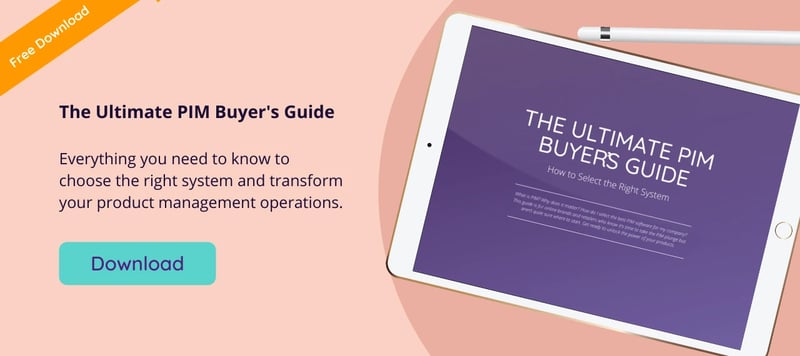
Keep the good stuff coming
Subscribe to our blog newsletter and get monthly content that helps you manage product data smarter.
No spam. Just real value.
Working with complex and ever-changing product information gives many ecommerce businesses endless headaches. To add to the already existing pressure you’re facing, you also have to keep up with the demand for rich product information and seamless customer experiences.
Modern customers are certainly a tough crowd. But that’s why you’re here searching for a product information management (PIM) solution that will help your teams work more efficiently and take control over your whole product data. To whip it up into perfect shape to ensure that it meets (and exceeds) customer expectations.
We understand that shopping for a product information tool is not, to borrow an old phrase; “a walk in the park.” There are a lot of things to take into consideration. But to get the answers you need, you have to know what to ask PIM tool providers. That way, when you book a demo with PIM specialists you’re already prepared. Most importantly, so that you can leave the meeting confident that you got the most out of the demo session and can either move on to the next provider or to the next step in the process.
Below, we’ll discuss the most important questions to ask in your PIM product demos.
1. How will your PIM tool help my business better manage product information?
This is an obvious question to ask right in the beginning of the conversation as it can set the tone for the rest of the session. The last thing you want to do is invest in product information management software that will complicate things even more than an Excel spreadsheet. Each potential PIM provider you speak to needs to explain the features that their tool comes with, specifically the ones that will help you better manage all of your product information that currently lives in silos.
Keep in mind that, for you to get the right answers, you need to clearly answer this question “why do you need a pim tool?” Different ecommerce businesses want to get PIM software for many different reasons.
Some may simply want PIM software to have a centralized repository for their product information, some want a more collaborative handle on their product information, while others may want it because their product catalog has grown. Another reason is having multistores in different regions of the world, which means that the product information comes in multiple languages. And, the same can be said for businesses that sell via multiple sales channels. The requirements of multichannel management of a large set of product data can signal the need for an automated solution.
Of course, you can want a PIM solution for all of these reasons at once, but what we’re pointing out here is that you have to specify your reasons upfront so that you can get the answers you need to decide whether the solution is suitable for your needs or not.
2. How does your tool handle digital assets? Can I share them with customers?
PIM and DAM (digital asset management) are conflated terms these days. But that couldn’t be further from the truth. A DAM system is separate from a PIM, and they each can offer small to large e-tail stores a very unique value. For instance, a DAM helps you store visual digital assets such as images, graphics, videos and enables you to create branding and marketing materials. However, a next-generation PIM can have DAM capabilities.
Plytix is a great example of a product content management software that comes with DAM capabilities for all types of files. And yes, that includes the ability to create marketing materials such as branded PDFs and online product catalogs.
Make sure you dig in to see if the PIM vendor you’re talking to can offer DAM capabilities because the last thing you want to do is implement a PIM and then realize that you’ll also need a DAM. Especially when you’re working with a tight budget. Don’t forget to ask about storage and media file limitations so you know from the beginning what’s possible and what isn’t.
Finally, you need to know whether you can share this kind of information with customers who ask for it in different formats. Some vendors might simply give you the ability to export information, but others will have a portal where your customers can directly download the information they want.
3. How does your PIM facilitate team collaboration for product data cleansing and enrichment?
Allow us to borrow yet another old phrase; “teamwork makes the dream work.” And, the only way teams can work well together, when there are so many moving parts, is to always be on the same page about everything. This eliminates possibilities of miscommunications, misunderstandings, and in a worst case scenario — sending out the wrong or inaccurate information to a customer or a supply chain partner.
That’s why collaborating on product data cleansing and enrichment is a crucial part of data management. They enable you to remove inaccuracies and add more details that can help customers come to a buying decision faster. So, to get a product data management tool that facilitates this process, ask the potential PIM partner to give you details on the qualities that help in this regard.
For example, with Plytix, you get unlimited users no matter which plan you choose. You’re able to create user profiles and roles and assign relevant permissions to each. But that’s just the starting point. Our platform allows you to create key attributes, where you can:
- Define the product owner
- Create product lifecycles (these are the stages you want your product to pass through)
- Create product validation (to validate the accuracy and completeness of a product)
- Choose departments involved
- Create workflows with Smart Lists (list of products users or departments are responsible for)
- Create user roles (to assign specific actions to each team member)
At Plytix, we believe that tracking collaboration keeps your teams on the same page and that’s something you should expect from a good PIM.
4. Can I syndicate product data from your system to the sales channels I sell from?
Ultimately, your product information has to go wherever you sell, and the distribution process should not feel like a tedious chore. So, of course, you want a product catalog management tool that makes product content syndication easy.
The PIM specialist you speak to should explain the different ways that their tool enables you to send product data to different ecommerce platforms such as Shopify, WooCommerce, and Magento, and marketplaces like Amazon, eBay, and Etsy. Some tools have Application Programming Interfaces (APIs) which are great because they’re automatic. However, oftentimes they require support in cases where an API breaks when that marketplace updates its API.
Some enable you to connect to a File Transfer Protocol (FTP). And, others can give you template generators to create a ready-to-go CSV, XML, or XLS file that becomes a live URL link when complete. For the most part, you have to upload the link to the sales channel. This is one of the most reliable and often most cost-effective data syndication options.
5. Does your PIM system require an IT team?
This is an important question to ask because you need to know what you’re getting yourself into. If you don’t have an IT team, you will be at a huge disadvantage if you take on a product data system that requires IT skills to set up and manage. This means that you have to think about whether an open source or a cloud-based solution is best suited for your business based on your available resources and infrastructure capabilities.
For instance, an open source PIM will require you to have an IT expert to implement and customize the system in a way that makes sense for your business. While a cloud-based PIM is hosted by the PIM company of choice, where you simply pay a licensing fee and they handle everything for you— from implementation to maintenance.
6. How are the pricing plans structured? Am I expected to pay for features I don’t use?
One of the greatest misconceptions in the ecommerce landscape is that product data management systems are too expensive for SMBs. And, while that may be true for vendors that specifically cater to larger businesses, there are other PIMs for small businesses. These types of tools are designed to serve the needs of smaller businesses, so they’re affordable.
If a PIM company isn’t upfront and open about their pricing, it’s for a reason. It means there are extra costs involved, things like consulting fees and extra charges for users or sales channels. These can quickly run you into the 6-digit figures for an annual license.
It will not be worth your time to go through a demo of a platform that is 5x above your budget. The sooner you know the pricing, the better. That’s exactly why we are transparent about our pricing for our different plans. You know exactly what you pay for a plan of choice and everything you get out of it, including the features you’re most likely to be interested in.
With Plytix, you’re not expected to cough up money for features you won’t use. We think it’s unfair to tie you into things you won’t use. It’s a financial loss no business should experience.
Final thoughts
Just to be clear, these are not the only questions you can ask. You’re free to ask whatever you want during your demo. But these are questions coming from our own knowledge and experience in the PIM industry. And, they’re very important questions because vendors can quickly rope you into investing in software that won’t best serve you.
We don’t do that, if we feel that your needs will be better served by another system, we’ll tell you that. We’re a PIM for ecommerce known for our whiteglove onboarding approach because our philosophy is, as our CEO always says; “the key to making a sale is helping the customer see how the product can help them.”
You can get the Plytix product demo experience and see for yourself by booking your demo session today. You can also download and read our FREE guide to shopping for a suitable PIM here.


What if your product data actually worked for you?
We’ll show you how Plytix helps you stop fixing data—and start using it.
Related posts
Keep the good stuff coming
Subscribe to our blog newsletter and get monthly content that helps you manage product data smarter.
No spam. Just real value.





Think others should see this?
Go ahead and share it.